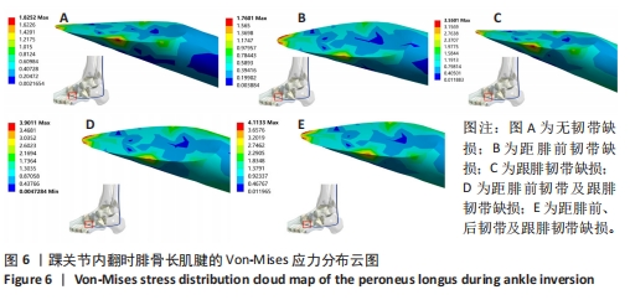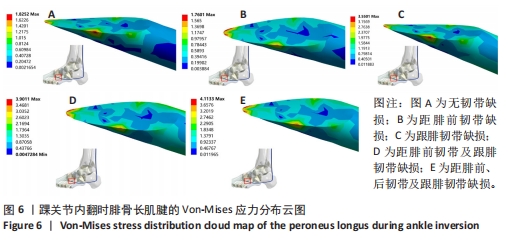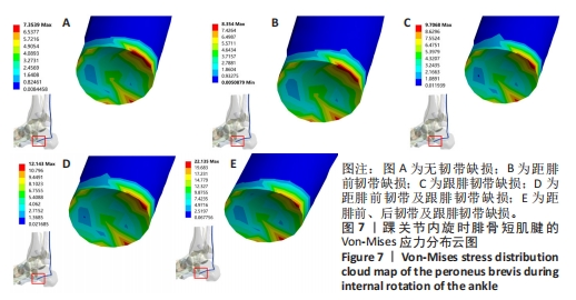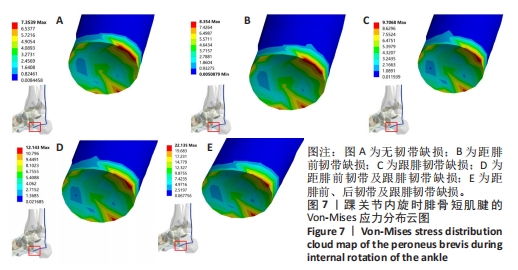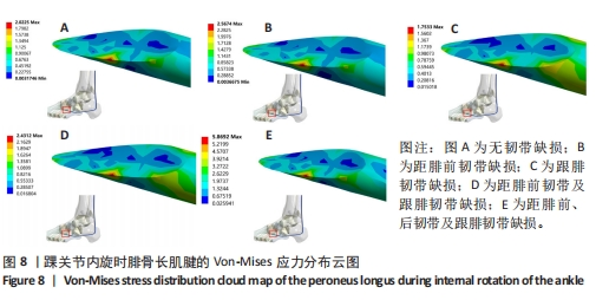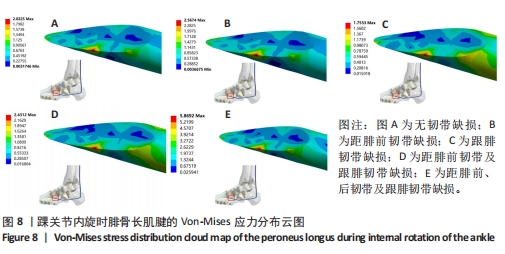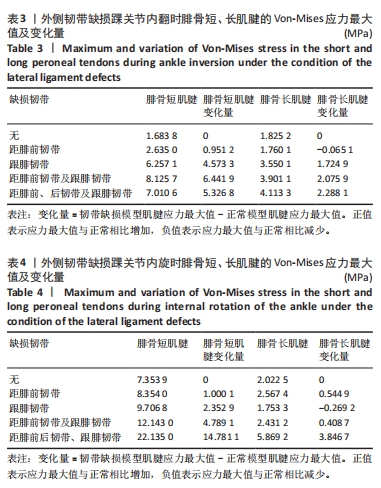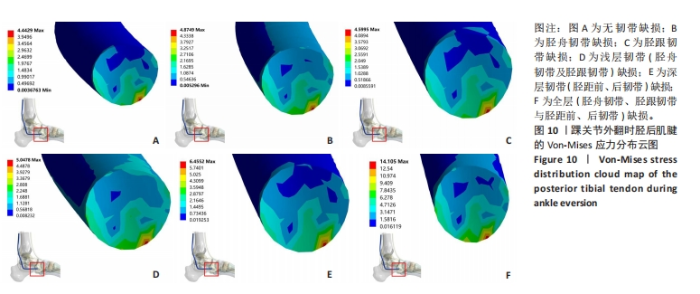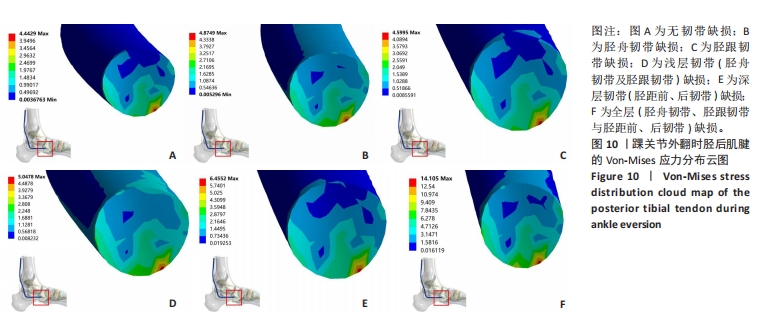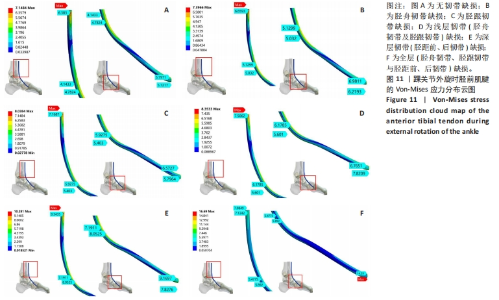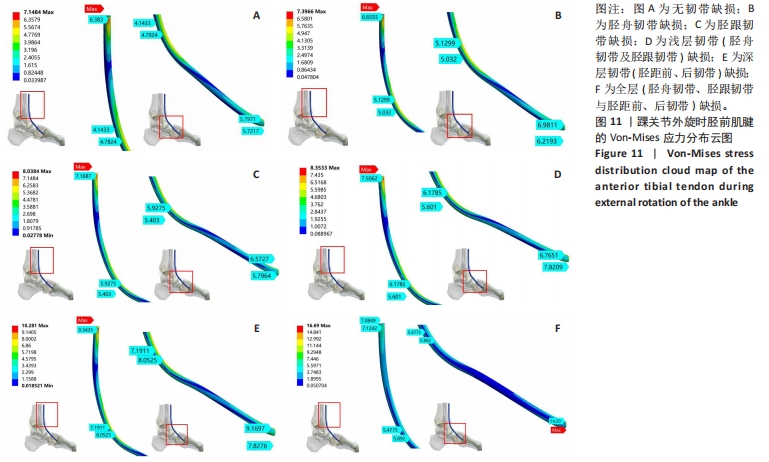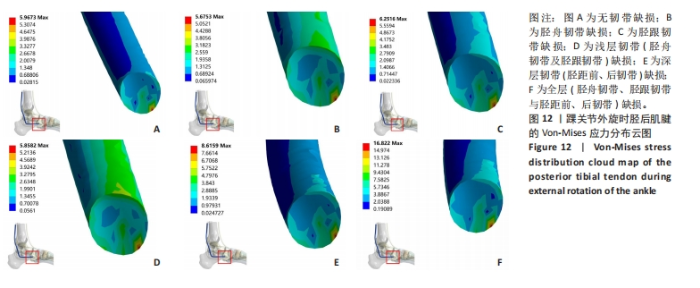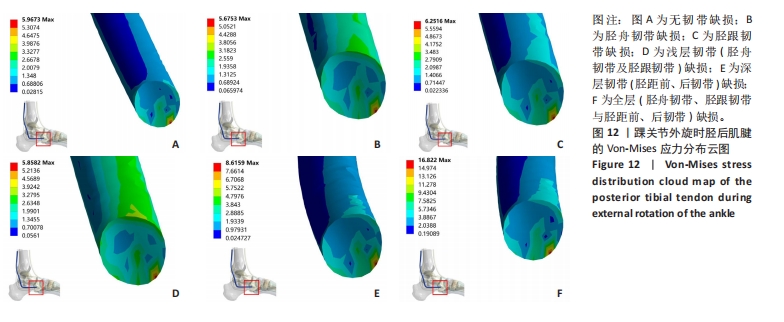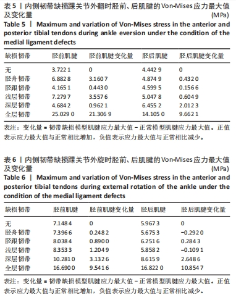Chinese Journal of Tissue Engineering Research ›› 2025, Vol. 29 ›› Issue (33): 7223-7230.doi: 10.12307/2025.914
Previous Articles Next Articles
Finite element analysis of biomechanical effect of medial or lateral malleolar ligament defects on its neighboring core tendons
Xu Tianyu1, Chen Modi1, Xie Mingru1, Ye Xinghua2, Pan Zhaohui2
- 1School of Clinical Medicine, Shandong Second Medical University, Weifang 261053, Shandong Province, China; 2Institute of Orthopedics and Traumatology of Chinese PLA, Hospital of Chinese PLA 80th Group Army, Weifang 261053, Shandong Province, China
-
Received:2024-09-19Accepted:2024-11-19Online:2025-11-28Published:2025-04-12 -
Contact:Pan Zhaohui, MD, Chief physician, Master’s supervisor, Institute of Orthopedics and Traumatology of Chinese PLA, Hospital of Chinese PLA 80th Group Army, Weifang 261053, Shandong Province, China -
About author:Xu Tianyu, Master candidate, School of Clinical Medicine, Shandong Second Medical University, Weifang 261053, Shandong Province, China -
Supported by:Weifang Municipal Health Commission Research Project, No. WFWSJK-2023-040 (to PZH)
CLC Number:
Cite this article
Xu Tianyu, Chen Modi, Xie Mingru, Ye Xinghua, Pan Zhaohui. Finite element analysis of biomechanical effect of medial or lateral malleolar ligament defects on its neighboring core tendons[J]. Chinese Journal of Tissue Engineering Research, 2025, 29(33): 7223-7230.
share this article
Add to citation manager EndNote|Reference Manager|ProCite|BibTeX|RefWorks
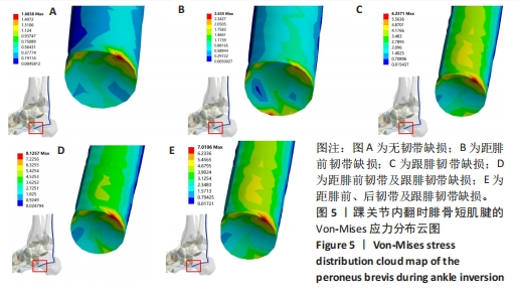
2.2 外侧韧带缺损对腓骨短、长肌肌腱等效应力的影响 内翻、内旋时腓骨短、长肌腱的最大Von-Mises应力均显著集中在肌腱远端,即足骨止点区,如图5-8所示。由表3,4数据可知,外侧韧带缺损将导致腓骨短肌腱应力载荷的最大值及增幅始终高于腓骨长肌腱。内翻时缺损韧带束增多导致腓骨长肌腱应力最大值增加,腓骨短肌腱应力最大值在距腓前韧带和跟腓韧带合并缺损达到峰值,外侧韧带均缺损时略有下降。内旋时缺损韧带束增多导致两者应力最大值均上升,外侧韧带均缺损时达到峰值。内翻时距腓前韧带缺损导致腓骨长肌腱的应力最大值较正常模型减少0.065 1 MPa,此时腓骨短肌腱的应力最大值增加0.951 2 MPa。内旋时跟腓韧带缺损引起腓骨长肌腱的应力最大值减少0.269 2 MPa,此时腓骨短肌腱的应力最大值增加2.352 9 MPa。"
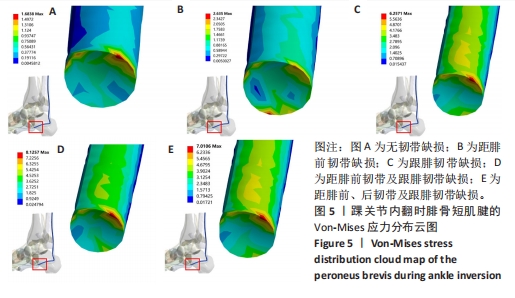
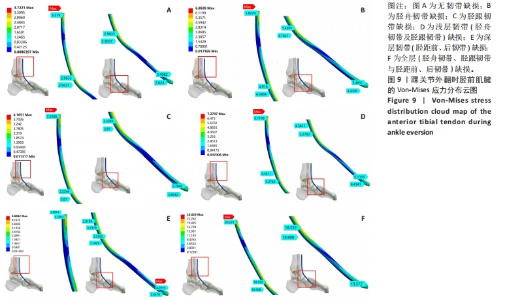
2.3 内侧韧带缺损对胫前、后肌腱等效应力的影响 外翻、外旋时胫前、后肌腱的Von-Mises应力分布如图9-12所示,胫前肌腱多区域均承担较高的应力载荷,胫后肌腱的应力分布集中在与足骨接触面。由表5,6可知,内侧韧带均缺损将导致胫前、后肌腱的应力最大值显著升高。外翻时内侧韧带缺损程度及类型将显著影响胫前、后肌腱的应力载荷:胫舟韧带、浅层或全层韧带缺损时胫前肌腱的应力最大值高于同条件下的胫后肌腱;若胫跟韧带、深层韧带缺损,胫后肌腱的应力最大值高于同条件下胫前肌腱。外旋时胫前、后肌腱的应力最大值较为接近,除内侧韧带全层缺损外,胫前肌腱的应力最大值略高于胫后肌腱。其中胫舟韧带缺损时胫前肌腱的应力最大值增加0.248 2 MPa,伴随胫后肌腱的应力最大值降低0.292 0 MPa;浅层韧带缺损时胫前肌腱的应力最大值增加1.204 9 MPa,伴随胫后肌腱的应力最大值降低0.109 1 MPa。"
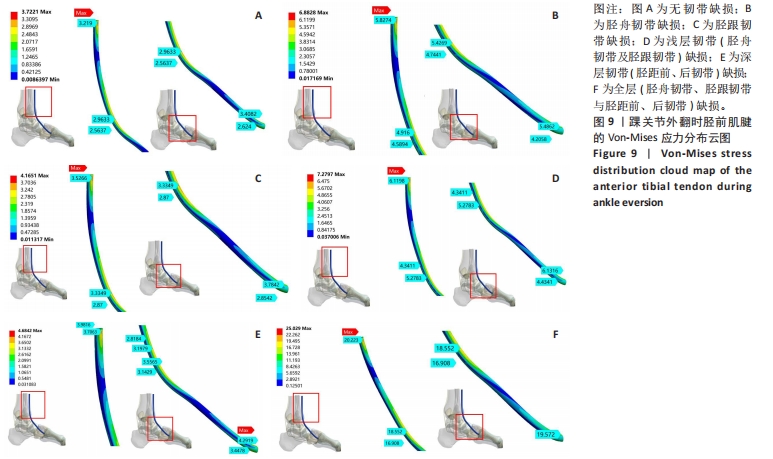
| [1] 杨海洲,杨秋翔,陈雨灵,等.踝关节外侧副韧带的解剖研究及对重建手术的意义[J].解剖学研究,2021,43(3):264-267. [2] VEGA J, GUELFI M. Arthroscopic assessment and treatment of medial collateral ligament complex. Foot Ankle Clin. 2021;26(2):305-313. [3] CRUZ-DÍAZ D, HITA-CONTRERAS F, LOMAS-VEGA R, et al. Cross-cultural adaptation and validation of the Spanish version of the Cumberland Ankle Instability Tool (CAIT): an instrument to assess unilateral chronic ankle instability. Clin Rheumatol. 2013;32(1):91-98. [4] 刘松波,李兴华,刘化文,等.自体腓骨短肌腱重建距腓前韧带和跟腓韧带治疗慢性踝关节外侧不稳定[J].中国骨伤,2022,35(2):172-177. [5] 鞠峰.部分腓骨短肌腱解剖重建陈旧性距腓前韧带损伤的临床疗效观察[D].青岛:青岛大学,2018. [6] YANG Z, LIU F, CUI L, et al. Comparison of the effects of reconstruction of the lateral ankle ligaments using peroneus longus and peroneus brevis tendon graft. Medicine. 2020;99(46):e22912. [7] KRIPS R, VAN DIJK CN, HALASI T, et al. Anatomical reconstruction versus tenodesis for the treatment of chronic anterolateral instability of the ankle joint: a 2-to 10-year follow-up, multicenter study. Knee Surg Sports Traumatol Arthrosc. 2000;8(3):173-179. [8] 张银龙,崔玉凤,张之智.切取腓骨长肌肌腱移植对踝关节外翻力度和角度的影响[J].中国骨与关节损伤杂志,2017,32(8):878-879. [9] HADDAD SL, DEDHIA S, REN Y, et al. Deltoid ligament reconstruction: a novel technique with biomechanical analysis. Foot Ankle Int. 2010; 31(7):639-651. [10] ISMAIL EE SR, AL SAFFAR RA, MOTAWEI K, et al. Defining the Components of the Deltoid Ligament (DL): a cadaveric study. Cureus. 2022;14(3):e23051. [11] DO AMARAL E CASTRO A, GODOY-SANTOS AL, TANEJA AK. Advanced imaging in the chronic lateral ankle instability: an algorithmic approach. Foot Ankle Clin. 2023;28(2):265-282. [12] BIANCHI S, BORTOLOTTO C, DRAGHI F. Os peroneum imaging: normal appearance and pathological findings. Insights imaging. 2017;8(1):59-68. [13] LI J, WEI Y, WEI M. Finite element analysis of the effect of talar osteochondral defects of different depths on ankle joint stability. Med Sci Monit. 2020;26:e921823. [14] 国婷婷,谢红,徐光华.弹性护踝防护性能的有限元分析[J].中国组织工程研究,2023,27(7):1031-1037. [15] 戴海飞,余斌,张凯瑞,等.踝关节周围韧带损伤对距骨稳定性影响的有限元分析[J].中国骨与关节损伤杂志,2012,27(2):121-124. [16] ZHANG Y, GUO Y, LONG X, et al. Analysis of the main soft tissue stress associated with flexible flatfoot deformity: a finite element study. Biomech Model Mechanobiol. 2021;20:2169-2177. [17] 边蔷,胡海威,温建民,等.足部相关肌肉-肌腱组织材料弹性模量的测定[J].中国组织工程研究,2015,19(12):1919-1923. [18] 许灿,张明彦,雷光华,等.踝关节内侧韧带损伤肌腱重建的三维有限元分析[J].中国组织工程研究,2012,16(35):6478-6483. [19] WANG CW, MUHEREMU A, BAI JP. Use of three-dimensional finite element models of the lateral ankle ligaments to evaluate three surgical techniques. J Int Med Res. 2018;46(2):699-709. [20] LEE KT, LEE JI, SUNG KS, et al. Biomechanical evaluation against calcaneofibular ligament repair in the Brostrom procedure: a cadaveric study. Knee Surg Sports Traumatol Arthrosc. 2008;16(8):781-786. [21] WILLIAMS J, DAVIES M, GUDURI V, et al. The multi-ligament ankle fracture: Epidemiology, key anatomical findings and fixation strategies in unstable open injuries. J Clin Orthop Trauma. 2023;36:102086. [22] LI Y, TONG J, WANG H, et al. Investigation into the effect of deltoid ligament injury on rotational ankle instability using a three-dimensional ankle finite element model. Front Bioeng Biotechnol. 2024;12:1386401. [23] CIFUENTES-DE LA PORTILLA C, PASAPULA C, GUTIÉRREZ-NARVARTE B, et al. Peroneus Longus overload caused by soft tissue deficiencies associated with early adult acquired flatfoot: A finite element analysis. Clin Biomech. 2021;86:105383. [24] KIM JS, YOUNG KW, CHO HK, et al. Concomitant syndesmotic instability and medial ankle instability are risk factors for unsatisfactory outcomes in patients with chronic ankle instability. Arthroscopy. 2015;31(8): 1548-1556. [25] CASADO-HERNÁNDEZ I, BECERRO-DE-BENGOA-VALLEJO R, LOSA-IGLESIAS ME, et al. Association between anterior talofibular ligament injury and ankle tendon, ligament, and joint conditions revealed by magnetic resonance imaging. Quant Imaging Med Surg. 2021;11(1):84. [26] SAKI F, YALFANI A, FOUSEKIS K, et al. Anatomical risk factors of lateral ankle sprain in adolescent athletes: A prospective cohort study. Phys Ther Sport. 2021;48:26-34. [27] YOSHIZUKA H, KURAOKA A. Calcaneofibular ligament may act as a tensioner of peroneal tendons as revealed by a contactless three-dimensional scan system on cadavers. Sci Rep. 2022;12(1):16650. [28] MIRANDA FC, KIHARA FILHO EN, PRADO MP, et al. Acute ankle injuries: association between sprain severity and ancillary findings. Einstein (Sao Paulo). 2023;21:eAO0162. [29] WILLIAMS III DS, MCCLAY IS, HAMILL J. Arch structure and injury patterns in runners. Clin Biomech. 2001;16(4):341-347. [30] ZWIRNER J, KOUTP A, VIDAKOVIC H, et al. Assessment of plantaris and peroneus tertius tendons as graft materials for ankle ligament reconstructions–A cadaveric biomechanical study. J Mech Behav Biomed Mater. 2021;115:104244. [31] WIERER G, GWINNER C, SCHEFFLER S. Peroneus Longus Split Versus Semitendinosus Tendon Autograft Size: A Cross-sectional Study. Am J Sports Med. 2023;51(7):1743-1751. [32] PUNNOOSE DJ, VARGHESE J, THERUVIL B, et al. Peroneus Longus Tendon Autografts have Better Graft Diameter, Less Morbidity, and Enhanced Muscle Recuperation than Hamstring Tendon in ACL Reconstruction. Indian J Orthop. 2024;58(7):979-986. [33] GOYAL T, PAUL S, CHOUDHURY AK, et al. Full-thickness peroneus longus tendon autograft for anterior cruciate reconstruction in multi-ligament injury and revision cases: outcomes and donor site morbidity. Eur J Orthop Surg Traumatol. 2023;33(1):21-27. [34] 董伊隆,钱约男,李一民,等.跟腓韧带解剖重建的解剖学研究[J].中国骨伤,2021,34(9):847-850. |
| [1] | Xu Hao, Ding Lu, Li Xiao. Investigating the effect of the mechanical wear on abutment screw in Morse taper connection implant implant system by using finite element analysis [J]. Chinese Journal of Tissue Engineering Research, 2025, 29(在线): 1-9. |
| [2] | Sun Xiaojun, Wang Huaming, Zhang Dehong, Song Xuewen, Huang Jin, Zhang Chen, Pei Shengtai. Effect of finite element method in treatment of developmental dysplasia of the hip in children [J]. Chinese Journal of Tissue Engineering Research, 2025, 29(9): 1897-1904. |
| [3] | Li Liangkui, Huang Yongcan, Wang Peng, Yu Binsheng. Effect of anterior controllable anteriodisplacement and fusion on vertebrae-ossification of posterior longitudinal ligament complex and implants: a finite element analysis [J]. Chinese Journal of Tissue Engineering Research, 2025, 29(9): 1761-1767. |
| [4] | Xu Biao, Lu Tan, Jiang Yaqiong, Yin Yujiao. Xu Biao, Lu Tan, Jiang Yaqiong, Yin Yujiao [J]. Chinese Journal of Tissue Engineering Research, 2025, 29(9): 1768-1774. |
| [5] | Zhou Jinhai, Li Jiangwei, Wang Xuquan, Zhuang Ying, Zhao Ying, Yang Yuyong, Wang Jiajia, Yang Yang, Zhou Shilian. Three-dimensional finite element analysis of anterior femoral notching during total knee arthroplasty at different bone strengths [J]. Chinese Journal of Tissue Engineering Research, 2025, 29(9): 1775-1782. |
| [6] | Chen Xi, Tang Tao, Chen Tongbing, Li Qing, Zhang Wen. Mechanical stability of intertrochanteric fracture of femur with different internal fixation systems [J]. Chinese Journal of Tissue Engineering Research, 2025, 29(9): 1783-1788. |
| [7] | Fu Enhong, Yang Hang, Liang Cheng, Zhang Xiaogang, Zhang Yali, Jin Zhongmin. OpenSim-based prediction of lower-limb biomechanical behavior in adolescents with plantarflexor weakness [J]. Chinese Journal of Tissue Engineering Research, 2025, 29(9): 1789-1795. |
| [8] | Li Kaiying, Wei Xiaoge, Song Fei, Yang Nan, Zhao Zhenning, Wang Yan, Mu Jing, Ma Huisheng. Mechanism of Lijin manipulation regulating scar formation in skeletal muscle injury repair in rabbits [J]. Chinese Journal of Tissue Engineering Research, 2025, 29(8): 1600-1608. |
| [9] | Li Dijun, Jiu Jingwei, Liu Haifeng, Yan Lei, Li Songyan, Wang Bin. Three-dimensional gelatin microspheres loaded human umbilical cord mesenchymal stem cells for chronic tendinopathy repair [J]. Chinese Journal of Tissue Engineering Research, 2025, 29(7): 1356-1362. |
| [10] | Lu Jieming, Li Yajing, Du Peijie, Xu Dongqing. Effects of artificial turf versus natural grass on biomechanical performance of the lower limbs in young females during jump-landing [J]. Chinese Journal of Tissue Engineering Research, 2025, 29(6): 1101-1107. |
| [11] | Li Shuai, Liu Hua, Shang Yonghui, Liu Yicong, Zhao Qihang, Liu Wen. Stress distribution on the maxilla when wearing the Twin-block appliance for Class II malocclusion [J]. Chinese Journal of Tissue Engineering Research, 2025, 29(5): 881-887. |
| [12] | Zhou Zonghao, Luo Siyang, Chen Jiawen, Chen Guangneng, Feng Hongchao. Finite element analysis of bioabsorbable plates versus miniature titanium plates in mandibular fracture fixation in different bone qualities [J]. Chinese Journal of Tissue Engineering Research, 2025, 29(4): 818-826. |
| [13] |
Zhang Bo, Zhang Zhen, Jiang Dong.
Tannic acid modified interpenetrating network hydrogel promotes tissue remodeling of ruptured Achilles tendon after surgery#br#
#br#
[J]. Chinese Journal of Tissue Engineering Research, 2025, 29(4): 721-729.
|
| [14] | Chen Yilong, Zhang Xu, Li Hong. Mechanical analysis of fiber post combined with different crown restorations for endodontically treated non-carious cervical lesions [J]. Chinese Journal of Tissue Engineering Research, 2025, 29(4): 866-871. |
| [15] | Yi Xiaoding, Zhang Di, Guo Hong, Qing Liang, Zhao Tianyu. Decellularized tendon scaffold: a biomedical material for tendon injury repair [J]. Chinese Journal of Tissue Engineering Research, 2025, 29(34): 7385-7392. |
| Viewed | ||||||
|
Full text |
|
|||||
|
Abstract |
|
|||||


